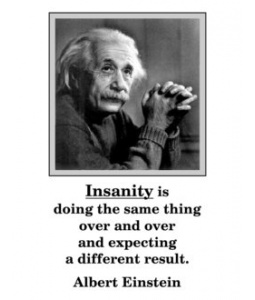The definition of organizational insanity is doing the same things over and over while expecting different results. As leaders, we have to challenge ourselves all the time to ensure that we are not on the revolving door of organizational insanity. For instance, leaders tend to put systems in place to ensure that all of the various requirements are completed (usually these are completed by others). We then do a “systems” check on the processes to determine if they are effective. When these systems become ineffective or breakdown, we seek ways to solve the problem. We then implement a new system (or a new feature) in order to address the problem. At the end, we repeat.
The problem that many leaders run into is that they struggle with metrics that are consistent to monitor their systems. All too often with so many “irons in the fire” it becomes difficult to monitor everything. This is the time that organizational insanity creeps in. Some leaders feel it is easier to just let things continue because, well, “that’s how we have always done things.” We all know things won’t just improve, and it takes a lot of reflection to battle organizational strategies.
How do you monitor organizational insanity?









